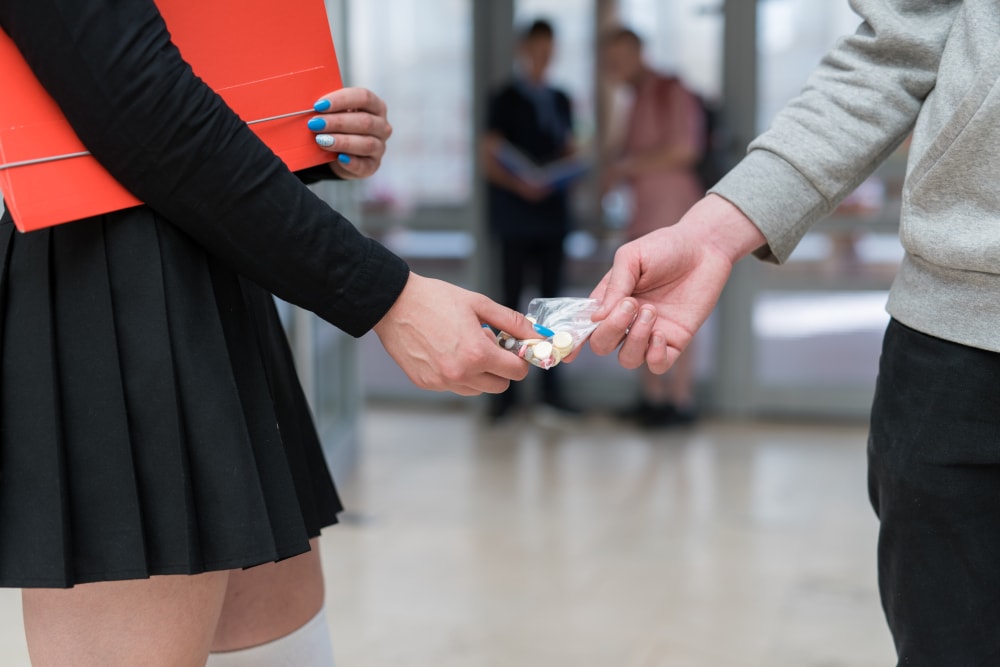
Xanax is a widely prescribed prescription medication used to address several mental health conditions, including mood and anxiety disorders. Medical and mental health providers prescribe Xanax to people of all ages as part of a treatment program to control anxiety and panic, among other symptoms. Xanax, while effective, is also widely misused and abused, leading to widespread dependency and addiction.
What is Xanax?
The drug Xanax is a prescription benzodiazepine. Also known as alprazolam, Xanax works by increasing the activity of specific neurotransmitters in the brain. Medical and mental health professionals prescribe Xanax to address symptoms related to specific anxiety disorders and symptoms of anxiety related to depressive disorders. In some instances, Xanax is also used to treat panic disorders.
Xanax increases the number of certain neurotransmitters in the brain. This helps lead to feelings of calm and relaxation and reduces panic. Like similar medications and other drugs in the same class, Xanax is safe and highly effective when used as directed by your medical or mental health provider. However, its use is not without side effects or risks. Unfortunately, despite its effectiveness as part of a mental health treatment program, Xanax is also widely misused and abused by people of all ages, including adolescents and teens.
A note about benzodiazepines
Benzodiazepines are depressant drugs. This means that their use produces feelings of relaxation, sedation, and sometimes hypnosis. Other drugs in the same class include Valium, Ativan, diazepam, and Klonopin. Benzodiazepines or benzos are only available through legal prescription; however, this does not reduce the number of illegal benzodiazepines available through nonprescription sources.
Many users have benzodiazepines increase their supply by doctor shopping (the practice of getting several prescriptions from multiple doctors), forging prescriptions, or buying them through online sources. Xanax and Klonopin are two of the most commonly abused benzodiazepine drugs.
Benzodiazepines are powerful sedative drugs. This means that when they are used alongside other depressants such as alcohol and opioids, it can lead to potentially fatal consequences. Sadly, it is not uncommon for both teens and adults to combine benzodiazepines and other depressants, especially alcohol. Recent studies show that up to 16% of overdose deaths related to benzodiazepines in 2020 also involved other sedative drugs.
Is Xanax Abuse Common in Teens?
Xanax is one of the most widely prescribed benzodiazepines in the United States. Statistics show that the number of Xanax prescriptions continues to grow yearly. Since 2004, The number has risen from approximately 18 million to just over 20 million in 2018. As high as the number from 2018 may be, it is vital to note that this is actually a decline from over 27 million in 2016. Because Xanax is widely available outside of a medical prescription, incidences of Xanax abuse in teens continue to rise. Studies on the prevalence of Xanax abuse in teens suggest three key reasons why Xanax abuse is so common in today’s youth.
Easy access
As mentioned above, medical and mental health providers write millions of prescriptions for Xanax annually. Although some prescriptions are provided to teens to address specific symptoms related to their mental health needs, others may look to other ways of obtaining Xanax. For example, prescriptions written for parents, grandparents, or friends. Unfortunately, quick and easy access to Xanax is not limited to the home environment.
Therefore, even if parents keep their medications in a safe and inaccessible place, it does not necessarily prevent teens from accessing Xanax from other sources. Today, online pharmacies and “black market” pharmacies provide alternate ways for teens to access Xanax and other prescription medications.
Higher stress levels
Today’s adolescents and teens experience higher levels of stress than previous generations. This is confirmed by the number of reported anxiety disorder cases increasing in teens year after year. In conjunction with increased anxiety disorder diagnosis, it follows that the number of Xanax prescriptions is also rising. Xanax is a quick-acting benzodiazepine. This means that the effects of the medication occur within a matter of minutes after use.
Xanax provides feelings of calm and relaxation in as few as 10 minutes. Unfortunately, the fast rate of action and effectiveness of Xanax in reducing unpleasant anxiety symptoms can lead to dependence. Some teens become dependent on Xanax to keep anxiety at bay, while others may develop a dependency on the drug to fall asleep or stay asleep at night. As mentioned above, Xanax addiction is often paired with dependence or addiction to other drugs, such as opioids and alcohol, leading to a dangerous and potentially deadly combination.
The effects of social media
Social and peer pressures are not new factors in teen development. However, peer pressure “looks” different today than it has in generations before. The rise of social media and social apps such as Instagram, Facebook, TikTok, and YouTube has led to a more effective way to propagate peer and social pressures. Today’s youth are faced with the implications of social media challenges such as the cinnamon challenge, the tide pod challenge, and others.
Because they see others participating, some teens feel inclined to as well to feel like one of the group. Dangerous social challenges aside, social media platforms have also presented new avenues for accessing dangerous substances such as Xanax and other drugs. These trends open the door to increased access to prescription drugs teens would not usually have easy access to. Sadly, this has also led to a dramatic rise in teen overdose deaths. Many of the prescriptions accessed online are not always what one believes they are purchasing. It is not uncommon for the “prescription black market” and drugs obtained from other online sources to contain combinations of dangerous substances such as fentanyl. In 2021, approximately 1150 teens died from drug-related overdoses linked to fentanyl-laced medications.
What are the Signs and Symptoms of Xanax Abuse?
As mentioned above, Xanax is an effective and beneficial component of mental health treatment. But as helpful as Xanax may be, the side effects of misuse or abuse of Xanax (and other benzodiazepine drugs) are a combination of psychological and physical effects. Unfortunately, it can sometimes be challenging to separate the adverse side effects of Xanax abuse from the drug’s desired effects. A list of possible signs and symptoms of Xanax abuse may include:
- Excessive drowsiness
- Dizziness
- Difficulties with concentration, memory, and judgment
- Blurry vision or “seeing double”
- Reduced coordination
- Slurred speech
- Stomach issues
- Problems breathing
- Loss of consciousness or coma
- Anxiety and depression
- Headaches
- Problems with sleep
- Thoughts of self-harm or suicide
Other indications of Xanax abuse are similar to the signs of addiction one may see if their teen or a loved one has an addiction to alcohol or another drug. For example, moodiness, more frequent or higher doses, obsessive thoughts about obtaining or using Xanax, finishing prescriptions too soon, or increased risky behaviors are among the other indications of Xanax addiction.
Teens who misuse or abuse Xanax may also experience various long-term effects on their academic successes and their relationships with peers and family. It is not uncommon for teens who develop an addiction or dependence on Xanax to have difficulties at school or to experience problems with social and personal relationships. Some teens may also have addictions to multiple substances or new mental health symptoms related to Xanax abuse.
How to Get Help for Your Teen at Beachside

Safely overcoming a dependence on Xanax requires the support and care found at a treatment program like ours at Beachside. Withdrawal from benzodiazepines like Xanax is safest when medical supervision during detox is part of your teen’s treatment plan. When someone reduces or stops taking Xanax, withdrawal symptoms generally occur. The severity of your teen’s symptoms will depend on several factors unique to your teen, including how often they take Xanax, how much they take, and how long they have misused or abused Xanax. Examples of Xanax withdrawal symptoms that may occur include:
- Increasing anxiety and depression
- Elevated blood pressure and heart rate
- Difficulties with sleep
- Sweating
- Tremors
- Seizures
- Hallucinations
Alongside supervised detox and withdrawal, it is crucial to engage in therapy designed to explore the underlying causes of Xanax abuse. Often the roots of Xanax misuse among teens relate to anxiety, stress, and other mental health concerns. Overcoming Xanax dependency requires addressing both the initial reason for Xanax use and the co-occurring dependence that develops when someone develops a tolerance to and cravings for its effects.
Studies suggest that cognitive-behavioral therapy (CBT), a type of talk therapy, is highly effective in helping people of all ages overcome Xanax addiction. CBT encourages participants to examine the thoughts and behaviors that may have led to Xanax misuse. Once the root cause of these thoughts and actions is better understood, exchanging unhelpful or harmful thoughts for positive and more productive ones is possible.
Another benefit to CBT is that the CBT therapy model is proven effective in addressing other types of addiction and various mental health treatment needs. CBT is an evidence-based therapy tool that effectively addresses anxiety, depression, trauma, and other mood-related disorders for which mental health providers often prescribe Xanax. CBT practitioners at Beachside will work with your teen to develop and practice new, healthier coping tools and methods to address their mental health symptoms without seeking or using Xanax.
Xanax misuse rates continue to rise among teens across the nation. Despite many of the known complications related to adolescent and teen Xanax (and benzo) use, it remains one of the more effective and therefore frequently prescribed drugs used in mental health symptom management. If you are concerned about your teen misusing or abusing Xanax, it is crucial to reach out to a treatment provider to take the first steps toward healing. To learn more about our programs and how we can help, contact a member of our admissions team today.
https://www.dea.gov/sites/default/files/2020-06/Benzodiazepenes-2020_1.pdf
https://nida.nih.gov/research-topics/opioids/benzodiazepines-opioids
https://www.statista.com/statistics/781816/alprazolam-sodium-prescriptions-number-in-the-us/
https://www.uclahealth.org/news/adolescent-drug-overdose-deaths-rose-exponentially-first





